Contents
Calla Lily (Zantedeschia)
The calla lily (Zantedeschia) is a striking flowering plant prized for its elegant, trumpet-shaped blooms and arrowhead-shaped leaves. This perennial bears a single showy spathe – often pure white or vibrantly colored – wrapped around a yellow spadix, creating the classic calla lily “flower.” Widely cultivated as an ornamental, it adds sophistication to gardens and floral arrangements. It is featured in many wedding flower guides for its graceful form and symbolism, and it frequently appears in sympathy and funeral arrangements, symbolizing purity and remembrance. The classic white calla lily is one of the most distinctive white flowers. Beyond the traditional white form, calla lilies come in an array of colors ranging from soft pink flowers and sunny yellow to rich red and deep purple – even near-black cultivars often called black calla lily varieties. Despite the name, this plant is not a true lily, it belongs to the arum family (Araceae). It shares a similarly stately presence and is admired for its beauty. With a preference for mild climates, moist soil, and bright light, the calla lily has become a favorite among gardeners and florists, valued as a hardy landscape plant in warm regions and a stunning cut flower.
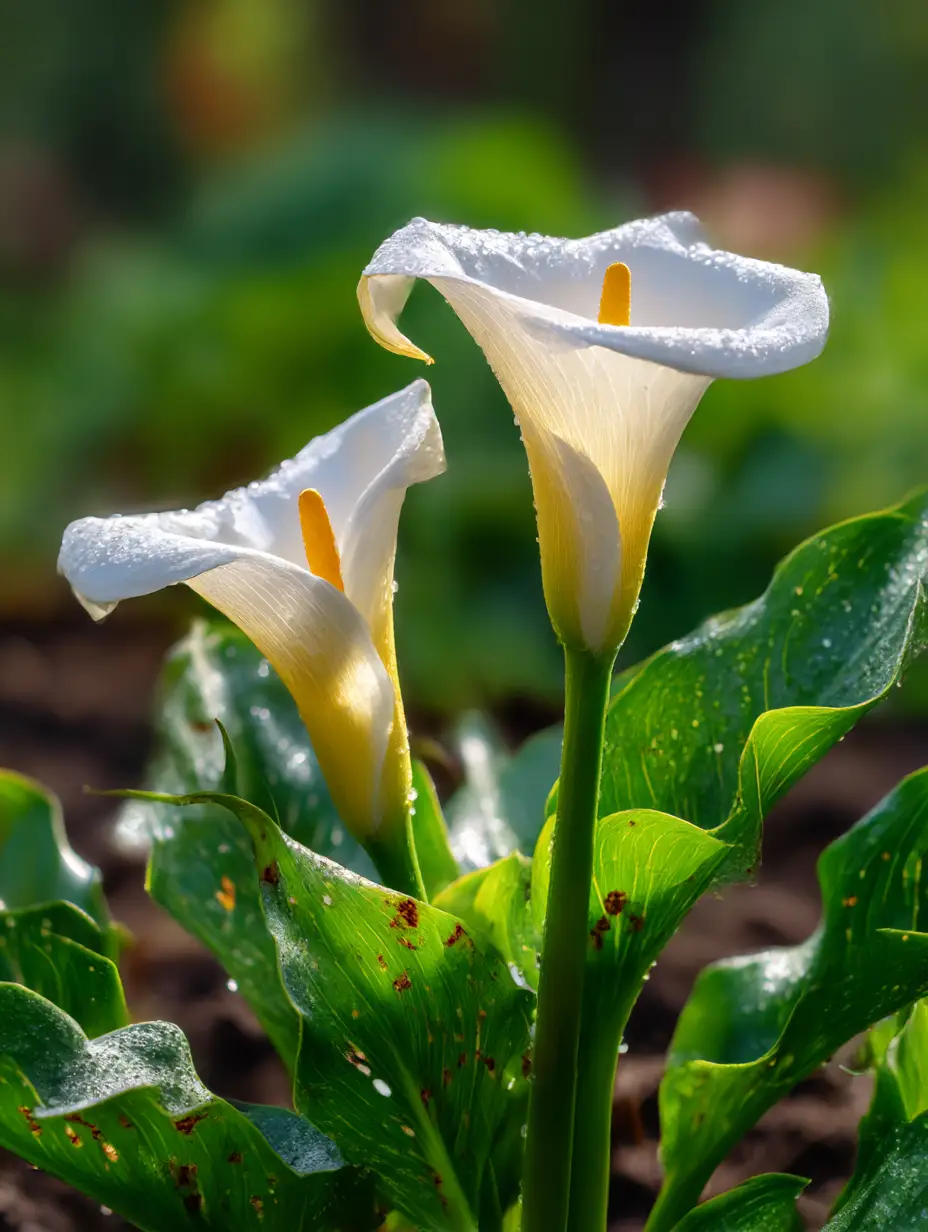
🌱 Taxonomy and origin
The calla lily belongs to the genus Zantedeschia in the arum family (Araceae). Despite its common name, it is not a true lily (true lilies belong to the genus Lilium in the lily family). Zantedeschia comprises several species native to southern Africa. The most well-known is Zantedeschia aethiopica, the classic white calla lily, found in marshes and along stream banks from South Africa north into Lesotho and Eswatini (Swaziland). Other species – such as golden Z. elliottiana and pink Z. rehmannii – have contributed to the many colorful hybrids grown in gardens today. These plants were introduced to Europe and America as ornamentals and have since become popular worldwide (even naturalizing in some mild climates). The name “calla” comes from the Greek word kallos, meaning beauty, an apt description of its blossoms. The genus name Zantedeschia honors Italian botanist Giovanni Zantedeschi. From its exotic African origins to global cultivation, the calla lily now graces gardens and bouquets far beyond its homeland.
🌸 Bloom time
Calla lilies typically bloom in early to mid-summer. In most temperate regions, the flower buds emerge in late spring and the plants showcase their blooms from around May or June through July. The exact bloom time can depend on the variety and climate: for instance, in warmer climates with ample moisture, the common white calla lily (Zantedeschia aethiopica) may start blooming earlier and continue intermittently beyond the summer months. Each individual bloom – the colored spathe surrounding the central yellow spadix – remains attractive for several weeks, giving calla lilies a relatively long flowering display. Gardeners often appreciate that the flowers do not all appear at once, instead, new blooms can open in succession over a period of several weeks. After the main bloom season ends, the plant’s foliage continues to grow for a time, gathering energy before the calla lily eventually enters a dormancy period (especially in climates with a cold or dry season).
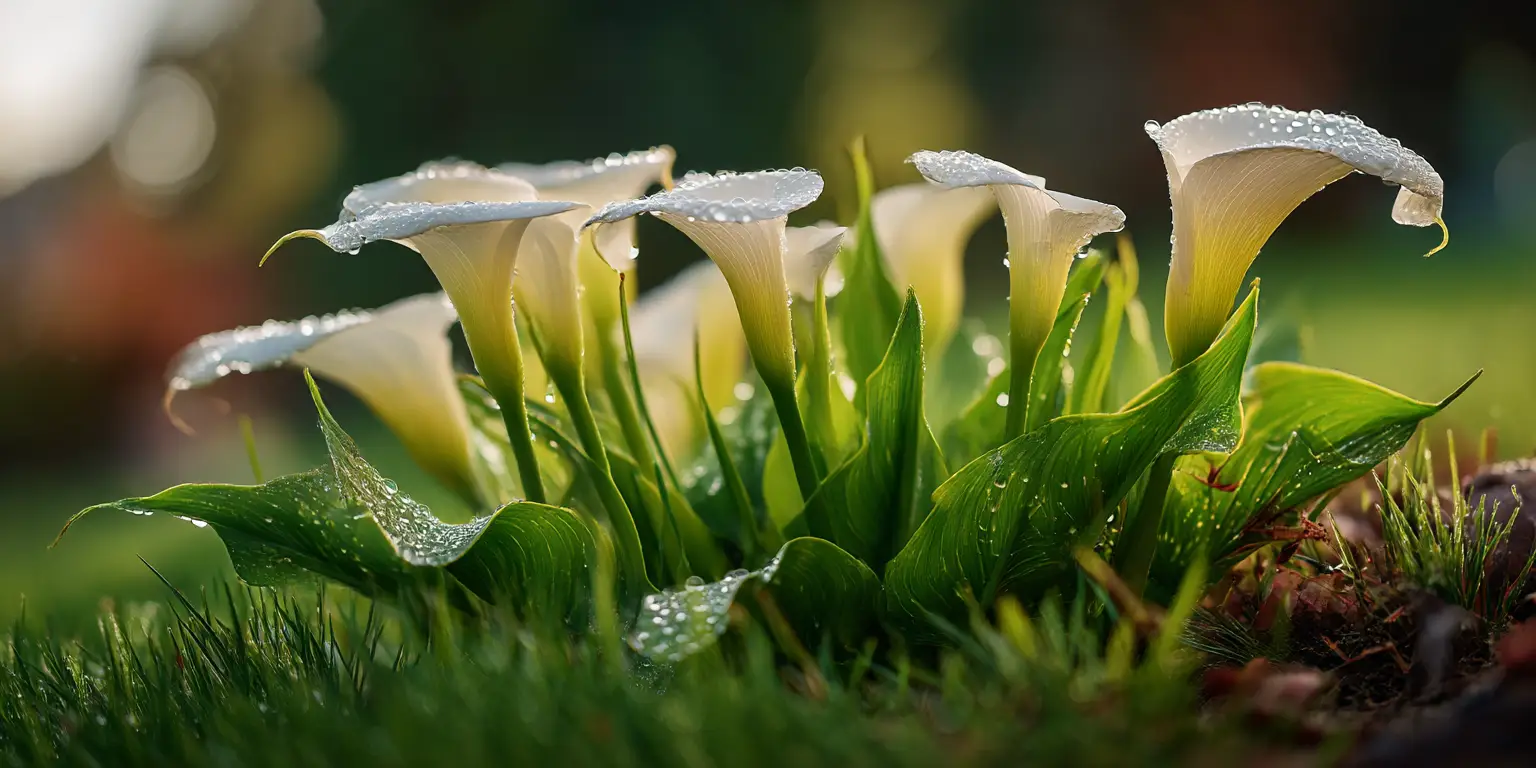
📏 Height and spread
Calla lilies have a modest stature, generally growing between 1 and 3 feet tall (approximately 30 to 90 cm) depending on the variety. The common white calla lily typically stands about 2 to 3 feet in height when in bloom, whereas many hybrids “mini” calla lilies are more compact, often reaching only 12 to 18 inches (30 to 45 cm) tall. Each plant forms a clump of upright, long-stemmed leaves and flower stalks arising from a fleshy rhizome. The leaves are usually arrowhead-shaped and can be quite sizable – on larger varieties they may grow up to a foot (30 cm) long, sometimes adorned with pale white spots. In terms of spread, an individual calla lily plant usually occupies roughly 1 to 2 feet (30 to 60 cm) of width. Over time the rhizomes multiply, causing the clump to expand gradually. Gardeners typically space calla lily rhizomes about 12 to 18 inches apart to allow room for growth and good air circulation. This gradual spread means calla lilies will form ever-larger clumps over the years, which can be divided periodically if they become crowded.
☀️ Light
Calla lilies thrive in bright light and can grow well in full sun or partial shade. The optimal light exposure often depends on your climate. In regions with mild or cool summers, calla lilies can handle full sun, which often leads to more vigorous growth and plentiful blooms. However, in hot climates (especially areas with strong afternoon sun), these plants benefit from partial shade to prevent leaf scorch and flower wilting. A common strategy is to provide morning sun and light afternoon shade, so the calla lily receives several hours of bright light without the stress of intense mid-day heat. Too much shade, on the other hand, can result in fewer blooms and leggy growth. Striking a balance is key – generally aim for at least a half day of sun (or bright filtered light all day) for best flowering. If growing calla lilies indoors or in a greenhouse, place them near a bright window but avoid direct scorching sun through glass. Proper light conditions will keep the foliage lush and help produce the maximum number of flowers.
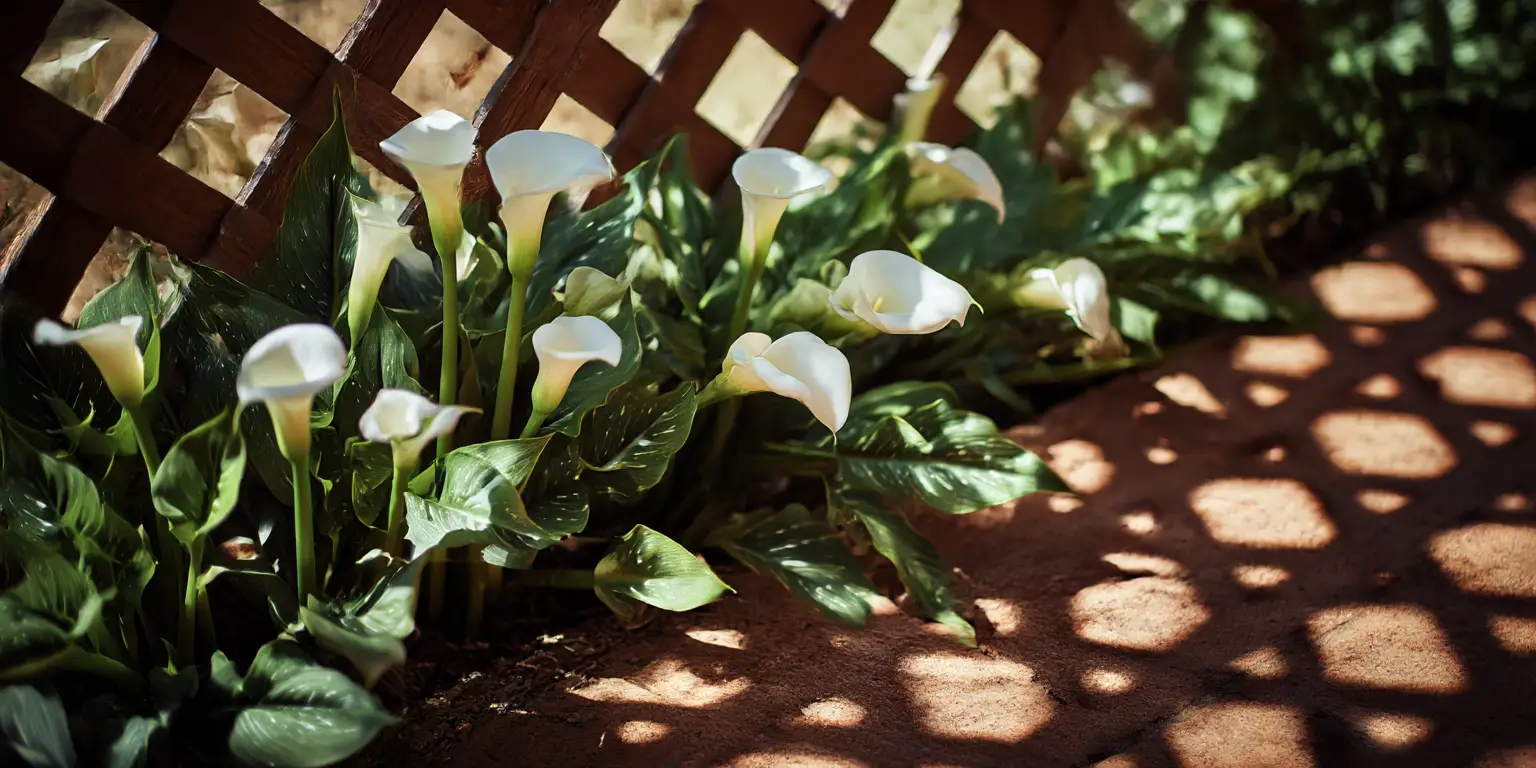
💧 Water
Consistent moisture is essential for calla lilies. These plants naturally grow in moist, marshy areas, so they prefer evenly damp (but not stagnant) soil in cultivation. Water calla lilies regularly during their active growing and blooming season to keep the soil consistently moist. They do not tolerate prolonged drought, if the soil dries too much, the plant may go dormant early and flowering will suffer. While calla lilies love moisture, the soil or potting mix should still drain well. Standing water around the rhizomes (especially in cool weather) can lead to rot, so good drainage is important. If planting in containers, ensure the pot has drainage holes and water whenever the top inch of soil feels slightly dry to the touch. Calla lilies can even grow at the edges of ponds or water gardens, demonstrating their high-water tolerance, but in typical garden settings it’s best to keep them evenly moist without waterlogging. After flowering, as the plant enters dormancy, watering can be gradually reduced and the soil allowed to dry out more between waterings. Providing a steady supply of moisture during the growing months will yield the healthiest plants and the most abundant blooms.
🌍 Soil and pH
Plant calla lilies in rich, well-draining soil that also retains moisture. A loamy soil amended with organic matter (such as compost or leaf mold) provides ideal conditions – it holds moisture without waterlogging and offers ample nutrients. Good drainage is important: while calla lilies love moisture, their roots should not sit in stagnant soggy soil. In heavy clay, work in amendments like compost or coarse sand to improve aeration. Regarding soil pH, calla lilies are quite adaptable. They do best in neutral to slightly acidic soils (around pH 6.0 to 7.0). They can tolerate somewhat more acidic or slightly alkaline conditions, but extreme pH levels can lead to nutrient deficiencies. In most garden soils that are moderately fertile and consistently damp (but not swampy), calla lilies will thrive. For container plants, use a high-quality potting mix rich in organic matter that drains well. Providing the right soil environment – nutrient-rich, moist, and well-aerated – will result in robust root development and lush growth.
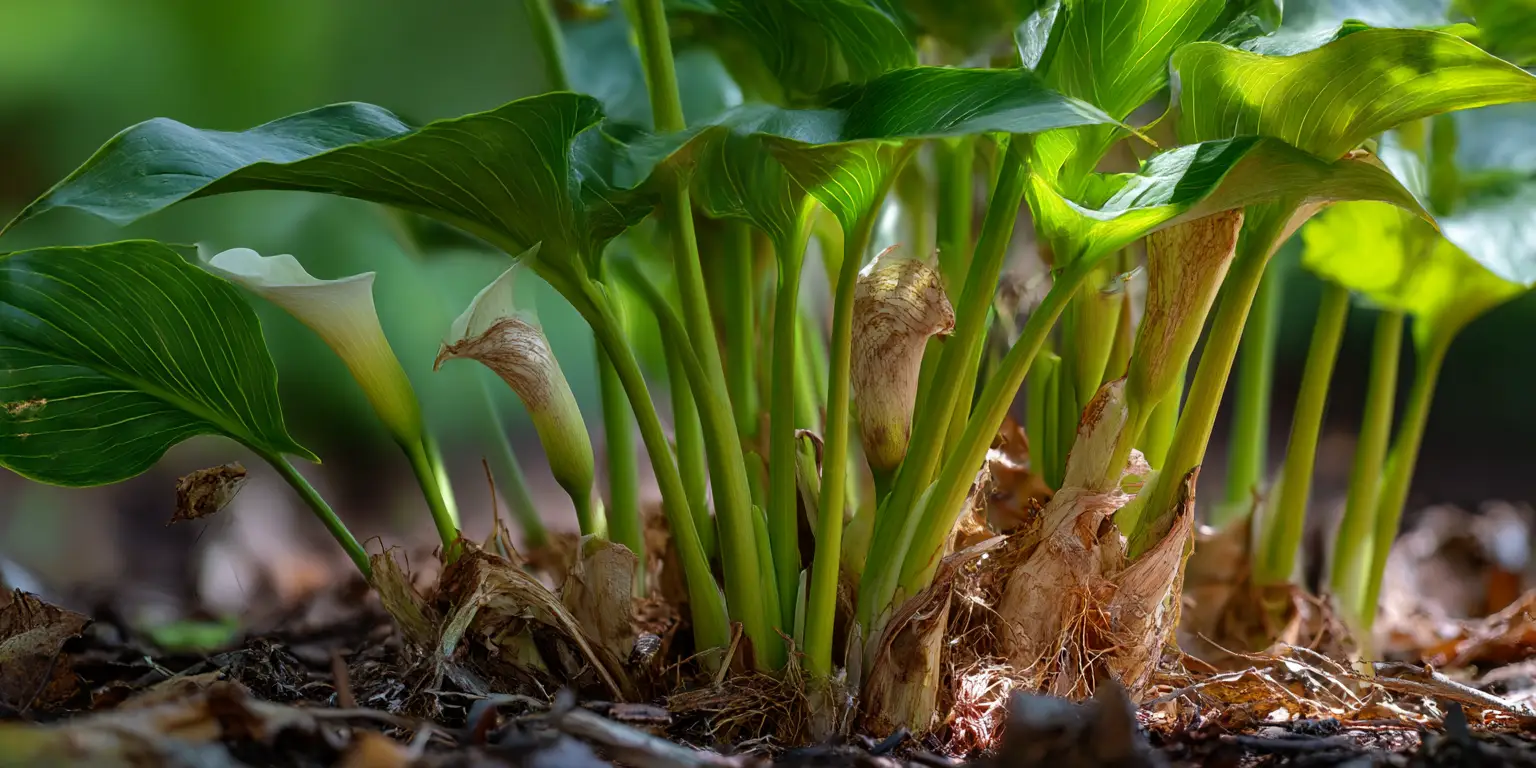
❄️ USDA hardiness
Calla lilies have limited cold tolerance. They can usually survive winters outdoors in USDA Hardiness Zones 8-10. In those mild climates, the rhizomes can be left in the ground year-round (the plants may go dormant in winter and then re-sprout in spring). In Zone 7, outdoor survival is marginal – a thick mulch or a sheltered microclimate might help them pull through a mild winter, but a hard freeze can still kill the rhizomes. In regions colder than Zone 7, calla lily rhizomes will not survive winter if left in the ground. Gardeners in these colder climates typically dig up the rhizomes in fall to save them for the next season. To overwinter calla lilies, lift the rhizomes from the soil after the foliage dies back (before the ground freezes). Brush off excess soil and allow the rhizomes to air dry for a day or two. Then store them in a cool, dry indoor location (such as a basement or garage) over the winter. When spring arrives and the danger of frost has passed, the stored rhizomes can be replanted outdoors to grow and bloom again.
🌼 Propagation and longevity
Calla lilies are most often propagated by dividing their rhizomes. To divide, wait until the plant is dormant – typically in late summer after flowering or in early spring before new growth. Dig up the clump and separate the rhizomes, making sure each piece has at least one bud or growing eye. You can pull them apart by hand or cut larger rhizomes with a clean knife. Allow the cut sections to dry for a day (to callus and reduce rot risk), then replant them at the same depth as before. Each division will grow into a new plant. Gardeners in cold climates who lift rhizomes for winter storage can divide them before replanting in spring. Alternatively, calla lilies can be grown from seed, but this method is slow and less reliable. Seeds may take weeks to germinate, and seedlings often require 2-3 years to reach flowering size. Moreover, if seeds come from hybrid varieties, the new plants may not look like the parent. Due to these challenges, propagation by rhizome division is the quickest way to get more calla lilies that will bloom true to type. With proper care, a calla lily clump can bloom annually for many years.
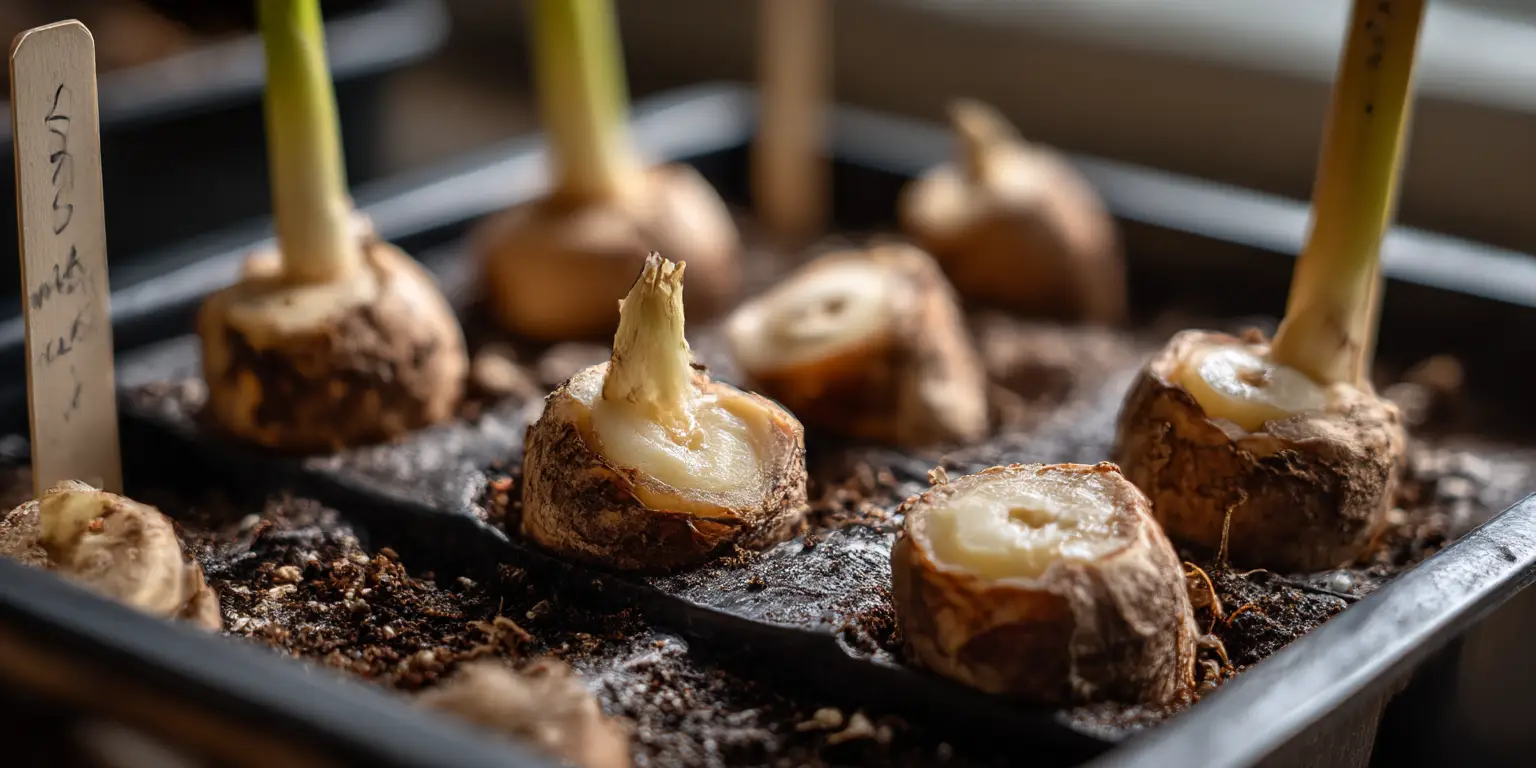
👃 Fragrance
Calla lilies are not particularly known for fragrance. In fact, most calla lily blooms are considered virtually scentless to the average nose. If you come very close to the flower, the central yellow spadix of the common white calla lily (Zantedeschia aethiopica) may emit a very mild, sweet scent, but it is quite faint and easily missed. Unlike some flowers (such as roses or true lilies) that fill the air with perfume, calla lilies maintain a low profile in terms of aroma. This subtle (or absent) fragrance can be an advantage for those who are sensitive to strong floral scents or for indoor displays and events where overpowering fragrance is not desired. Essentially, calla lilies are grown and appreciated for their striking form and visual elegance rather than for a notable scent. Gardeners and florists value them for their beauty and longevity rather than any perfume, so don’t be surprised if your calla lily bouquet doesn’t have a noticeable smell.
⚠️ Toxicity and pet safety
All parts of the calla lily plant are toxic if ingested by pets or children. The tissues contain insoluble calcium oxalate crystals – tiny needle-like compounds that cause intense irritation when chewed or swallowed. If a cat or dog bites into a calla lily, these crystals immediately irritate the mouth and throat, leading to severe pain, drooling, and difficulty swallowing, vomiting may follow. Most animals stop after the first bite because of the pain, so serious poisoning is rare. However, the ordeal can be very uncomfortable and may require a veterinary visit. It’s best to keep calla lilies out of reach of cats, dogs, and curious kids.
Note: Calla lilies are not true lilies (like Easter lilies or daylilies), which can cause fatal kidney failure in cats. Calla lilies typically only cause mouth and stomach irritation, not kidney damage. Nonetheless, any pet that eats part of this plant should be watched and a veterinarian consulted if symptoms are severe. The sap from calla lily stems or leaves can also irritate human skin on contact, causing redness or itching in sensitive individuals. For safety, wear gloves when handling or pruning calla lilies, and wash skin if exposed to the sap.

🌿 Vase life
Calla lilies are prized in floral design for their elegance and longevity as cut flowers. When cut at the right stage and given proper care, a calla lily bloom can last about a week or more in a vase. Typically, you can expect around 5 to 10 days of freshness from cut calla lilies. To maximize longevity, cut the stems at an angle with clean shears and immediately place them in fresh water. Keeping the vase water clean is key: replace the water every couple of days, and trim a small portion off the bottom of each stem at the same time to ensure continued water uptake. Display the arrangement in a cool location out of direct sunlight and away from heat vents. Calla lily stems can sometimes cloud the vase water, so frequent water changes help prevent bacterial buildup that could shorten their vase life. Unlike some flowers that drop petals as they age, calla lily blooms remain intact, they will gradually discolor or soften after many days. You can remove any bloom once it starts to fade while the remaining flowers continue to look fresh. With these simple care steps, calla lilies will remain an eye-catching part of your bouquet for a long time.
🐛 Pests and diseases
Pests
Calla lilies are generally hardy plants, but a few pests can occasionally cause problems. Common sap-sucking insects like aphids may cluster on new shoots and buds, feeding on the plant’s juices and causing distorted growth or sticky “honeydew” residue on the leaves. Spider mites can appear in hot, dry conditions (especially on indoor or greenhouse plants), leaving fine speckling or a silvery stippling on the foliage. Mealybugs, which look like tiny white cottony masses, might infest indoor potted calla lilies or greenhouse specimens, weakening the plant by sucking sap. Outdoors, slugs and snails are attracted to calla lilies’ tender leaves, chewing irregular holes especially in damp, shaded beds. In some regions, Japanese beetles may also feed on the leaves and flowers. To manage these pests, regularly inspect your plants. A strong spray of water can knock off aphids and mites, or use insecticidal soap on heavy infestations. Hand-pick slugs and snails or use appropriate bait/traps if they become a nuisance. Overall, keeping the plant healthy and not overly stressed will make it less susceptible to pest outbreaks.
Diseases
The most significant disease issue for calla lilies is rot, particularly rhizome rot or root rot, which occurs if the soil stays waterlogged. Fungal pathogens (like Pythium or Phytophthora) thrive in overly wet conditions and can cause the rhizomes to become mushy and the leaves to yellow and collapse. To prevent rot, ensure good drainage and avoid overwatering – the soil should be moist but not constantly saturated. Planting in raised beds or adding coarse material to the soil can help in heavy soils. Other diseases are relatively uncommon but can include fungal leaf spots or blights in warm, humid weather. These might appear as brown or black spots on foliage. If noticed, remove and dispose of the affected leaves to prevent spread, and consider applying a general garden fungicide if the problem persists. Powdery mildew (a white powdery coating on leaves) could develop in conditions of poor air circulation, though it is not a frequent issue for calla lilies. Spacing plants well and keeping the area weed-free can minimize fungal problems. In general, calla lilies are not highly disease-prone when grown in appropriate conditions, and prompt attention to any emerging issue will keep them healthy.
FAQs
Are calla lilies true lilies?
No, calla lilies are not true lilies. Despite their name, they belong to the Araceae (arum) family, not the lily family. True lilies are plants in the genus Lilium (such as Asiatic or Easter lilies). Calla lilies (genus Zantedeschia) have a different botanical background. They share the “lily” name because of their lily-like flower form, but biologically they are quite distinct. Calla lilies also grow from rhizomes (thick underground stems), whereas true lilies grow from true bulbs. One practical difference is that true lilies are often highly fragrant and extremely toxic to cats (causing kidney failure), whereas calla lilies have little to no fragrance and cause irritation rather than the same kind of severe toxicity.
Do calla lilies come back every year or are they annuals?
Calla lilies are perennials in the right conditions. In warm climates (roughly USDA Zone 8 and above), they can stay in the ground and will come back and bloom year after year. In colder regions, calla lilies won’t survive the winter outdoors, but you can treat them as perennials by digging up the rhizomes in the fall and storing them indoors until spring. If you don’t store them (or you’re in a zone where they can’t survive), they will function like annuals (needing replanting each year). So, whether they behave as annuals or perennials depends on your local climate and how you manage the rhizomes.
Are calla lilies poisonous to pets or children?
Yes. Calla lilies contain calcium oxalate crystals that can irritate the mouth and throat if chewed or eaten by pets (cats, dogs) or children. Symptoms often include immediate mouth pain, drooling, and difficulty swallowing, and possibly vomiting. The good news is that this intense irritation usually prevents most animals or kids from ingesting a lot – so serious poisoning is uncommon. However, it can be quite painful, and it’s important to keep calla lilies out of reach to be safe. If a pet or child does chew on a calla lily, rinse out their mouth with water if possible and seek medical or veterinary advice for further instructions.
How do I overwinter calla lilies in a cold climate?
If you live in an area where winter temperatures drop below freezing (colder than Zone 7), you’ll need to lift and store your calla lily rhizomes to keep them alive for the next year. After the plant finishes blooming and once frost kills back the leaves, gently dig up the rhizomes from the ground. Brush off excess soil and allow them to air dry for a couple of days. Then place the rhizomes in a breathable bag or box with some dry peat moss, wood shavings, or even newspaper to keep them from touching each other. Store them in a cool, dark place (around 40-50°F, such as a basement or garage that doesn’t freeze). In spring, after the danger of frost has passed, replant the rhizomes outdoors in the garden or in pots. They should sprout new growth as the weather warms. By overwintering the rhizomes this way, you can enjoy your calla lilies year after year even in cold climates.
Can calla lilies grow indoors or as houseplants?
Yes, calla lilies can be grown in containers and even brought indoors, although they have some specific needs. As houseplants or indoor potted specimens, they require plenty of bright light (a sunny window or strong indirect light) to bloom well. They also prefer cool to moderate indoor temperatures (around 60-75°F). You’ll want to keep the soil consistently moist but not waterlogged – good drainage is important even in a pot. Many people actually start calla lily rhizomes in pots indoors in late winter to get a jump on the growing season, then move them outdoors in spring. You can also keep a potted calla lily year-round, after it blooms, let it have a rest period (it may go dormant for a couple of months where it doesn’t grow much). Keep watering lightly during dormancy, and then resume normal care when new leaves start to appear. With enough light and proper care, calla lilies can indeed be enjoyed indoors.
What do calla lilies symbolize?
Calla lilies have a rich symbolic history in various cultures. Generally, they are associated with purity, holiness, and faithfulness. This is one reason white calla lilies are popular at weddings – they symbolize the purity of marital devotion. They are also commonly seen at funerals, as they can represent resurrection and rebirth (the idea of the soul rising, much like the calla lily’s flower rising from a dormant bulb). In addition, calla lilies have long been admired as a symbol of beauty (the word “calla” comes from the Greek kallos, meaning beauty). Their elegant, pristine appearance has made them an emblem of sophistication and elegance in floral arrangements. Of course, the meaning can vary slightly depending on context and color – for instance, a pink calla lily might symbolize appreciation or admiration. But overall, calla lilies carry positive connotations of purity, life, and beauty.